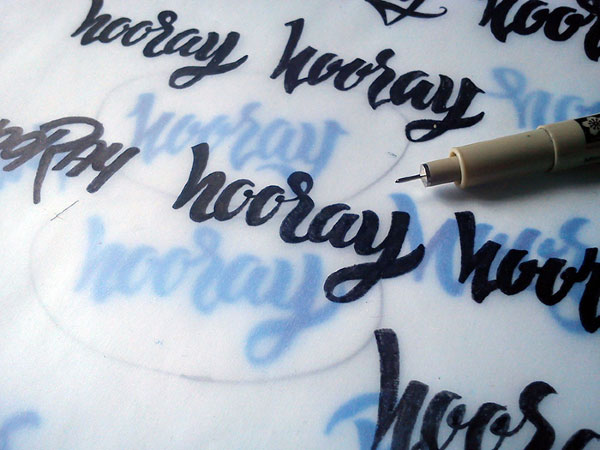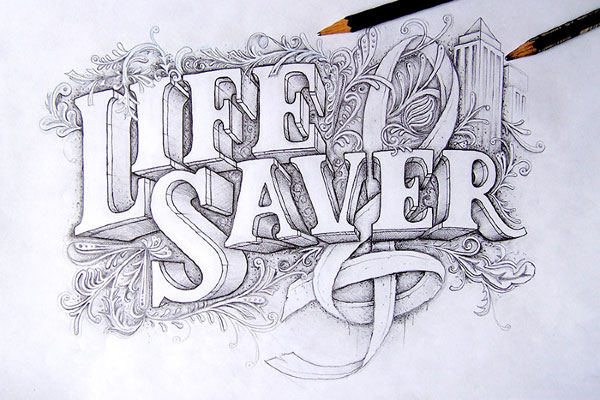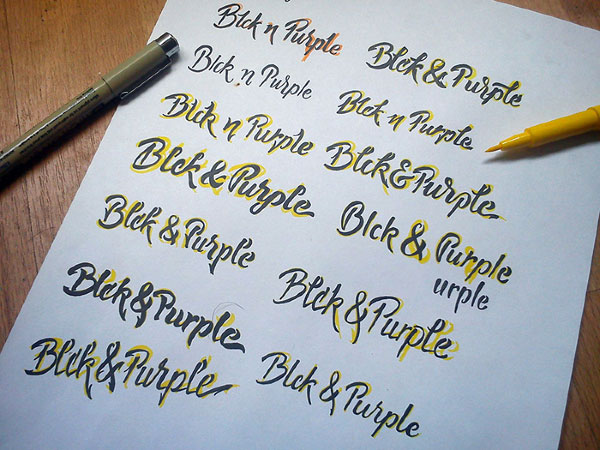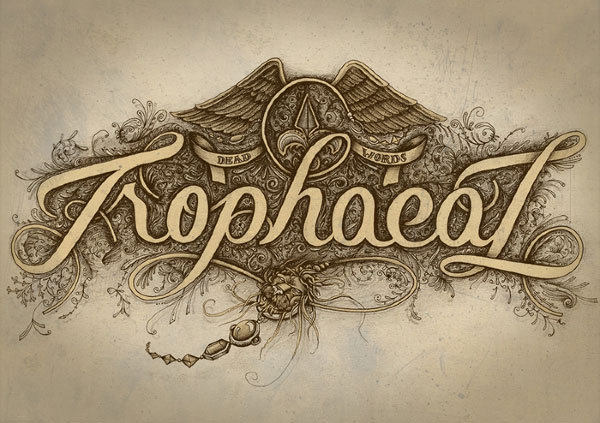One Minute With…
Joachim Vu

Hi Joachim, thanks for taking time to chat with One Minute With. Tell us a little bit about yourself and your work.
Hi Conor, thanks for having me! I’m a quarter-century old french designer trying to make a living out of my passion. Most of my work is about drawing things, and most of those things are letters.
How did you get into design? Was there a defining point in your career, and if so, how did it shape you as a designer?
I think I first came to design because it seemed a cool and easy way to make money without doing any “real” work. I was right about the “cool” part, and so wrong about the “easy” one. I pretty much didn’t care about anything when I was in school, so when I had to choose what to do for the rest of my life, all I wanted was a job which didn’t look like a job. With both my parents being in creative fields, I knew they would be supportive if I chose this route, and it seemed cool even if I didn’t know anything about it, so I went for it. Since I didn’t want to go to school, I started directly with internships that I managed to get with my poor Photoshop skills. I was paid for making things such as web banners, flyers and posters. It was crazy, even if at that time I didn’t really love design itself, I mostly loved the fact that I was getting money for something that didn’t feel like work.
After about a year, I finally decided to attend a work-and-study design school to feel more legitimate about my job, and get a degree. I have nothing against design schools – I know it’s probably just me not being fitted for such things, but I hated it. Being told “how” to do design, being forced to learn and do stuff I totally didn’t care about, I felt like I was wrong all that time about what I thought design was, and that I got involved in something so boring and codified. Truth is, I was wrong, but it’s definitely not school which gave me the love of design and taught me dedication and hard work. I spent those years spray-painting walls with my friends instead of doing my design assignments, and started to draw a lot for myself during my work days as a print designer in a shitty press agency where we had to do the job fast rather than good. I ended school by not showing up to the final exam, left my job and joined a small painting workshop. I was able to work on whatever I wanted, show up at 8am or 3pm, I was really free. I practiced my drawing, painting, and was encouraged to learn new stuff by myself. That may be the defining point you asked about because that’s the moment where I realized that my skills in design would only depend on my dedication and the amount of effort I put in. Since then, I learn and study more than I ever did before, and it turns out that I truly love my job. After that, freelancing, a lot of personal work, thousands of letters drawn, and more recently a new step with the creation of Hooraylabs with two friends of mine.

What do you think of as the biggest achievement in your career so far? And for balance, what do you consider your biggest failure?
Hard to tell, I feel like I have still so much to learn and try that I don’t even know if I can speak of a “career” for now. My biggest achievement to date may just be when I accepted that I wanted to do design the way I liked, not the way I’m told. Starting my own business, and also, specialize in lettering, which is what I love, instead of just being another designer in one of those big advertising agencies. To me, when you choose design as a career, it’s to be free and have control on what you do of your days, and how you do it. So if it’s to end up doing some work you don’t enjoy in a company where you just feel like another pawn on the chessboard, what’s the point?
About failures, man, I have failed quite a lot. I tried twice to enter one of the best art schools here in France, and failed the entrance exam twice, which made me ask myself a lot of questions about my work. Now, years have passed and I realize that I probably wouldn’t have enjoyed it anyway, but at that time it was tough. I have failed my design degree, not that I try hard, but still. What I consider my biggest failure is probably the fact that it took me time to realize that being a good designer is above all the result of a very personal process. I wanted to do something easy at first, so I kind of postponed the moment where I would have to really involve myself in it. Luckily, that moment finally arrived, and I couldn’t be more happy about that.

So, you co-run Hooray Labs, a design & development agency. How does this sorta set-up compare to working freelance? What new challenges does it bring?
It may be a bit too soon to really have a valuable opinion since we’re just started, but building its own business is something crazy for sure. When you work freelance you already have this “business” side of the job that can be surprising because it’s something you’re def not taught about in school. I’m not talking about making a quotation or an invoice, but how to handle a client, and make yourself stand as a professional. You have to care even more about that when you’re a company, because you’re not the only one involved, you just can’t say or do what you want – everyone has to talk the same language. Dealing with the administrative tasks, estimating taxes, having the right pricing for your services, all of that can be tough when freelancing, and it’s tougher within a company, but I feel like it’s nothing compared to the difficulty of building the right “image”. That’s why we also want to get involved in side projects, and open source, because as a company I think it’s a duty to really be a part of the industry and why not – Makes the job better! Maybe that’s too ambitious, but I think of when we’ll have to hire people – I want those people to be proud to work with us.
Also, one of the best things of working as an agency is that you’re looking for full projects. It’s not like making a logo under another agency’s creative director and having no power on how it will be used, or designing a website but having the branding imposed upon you, or a developer you don’t know and haven’t even met. Hooraylabs is a three-headed beast, and each one of us have our specialty, so we can take care of projects from its beginning to its end. I don’t want to talk too soon and I’d prefer to focus myself on hard work for now, but I hope that starting this business will be a way to participate on much bigger projects than I could have if I’d just keep freelancing.
And of course, you don’t have to spend your days with that asshole you hate since day one and you’re forced to bear because he’s your supervisor. We are three friends and we all love our jobs, so all we want is to have control on what we work on, and do the best of ourselves.
Now, come back next year, and we’ll see where we’re at, because there is so much to do and I think I can’t even imagine the half of what we’ll have to go through!

It seems that a huge portion of your process is sketching – How important do you feel this is? What about it do you prefer to digital work?
Sketching is the base of everything in design. No matter if the final product is digital of traditional, it should first start with sketching. I often hear that a good designer doesn’t have to know how to draw – I’m not sure I agree with that. Let’s say that a designer can be good without being able to draw, but he would be way better if he was. Drawing teaches you how things work together, how an object reacts to another object, to a source of light. It teaches you how colors work, how composition, perspective, and space work. I’m far from being a great drawer: I’m not very comfortable with portraits or human body for example, but I work a lot on perspective, lighting and composition, because it seems to me that they are essential elements of good design.
About working traditionally, it’s something I enjoy more and more. I like the fact that I can produce something with my hands that’s real, that I can touch. It just feels more honest, it has a story and people who see it can feel it too because there’s always little imperfections in handmade work that make your pieces so much more alive. And no matter how hard you try to simulate those effects in Photoshop with brushes, textures or whatever you want, it just won’t look the same. Of course, traditional is hard to sell today, so most of my handmade production is personal work for now, but I feel like it’s something I need to do.
Anyway I still like to work on the computer, it’s just about using the right tool for the right job. It’s fine to spend hours in Illustrator tweaking a logotype, looking for the perfect curve – it’s less fine to spend hours on Photoshop trying to recreate the imperfection of a brush stroke, while you could just use a real brush.
If, in some Freaky Friday-like situation, you could live the life of another designer, illustrator or creative, for a day, who would it be, and why?
It’s a tough one because there are so many talented designers I admire. Let me choose two. For the first twelve hours, I would want to be Doyald Young for the unequaled style – he’s responsible for some of the most beautiful letters I’ve ever seen. For the last twelve hours, let’s say Niels Shoe Meulman because he first inspired me as a graffiti writer, and then as a designer. I have mad respect for the guy and his career.

If you could change one thing about your career to date, what would it be?
What’s done is done! If I do something wrong I know I won’t do it again. Mistakes are part of the process of being better in what we do, at least I hope so, because I’ve made a ton. If you really want me to change something, that Indian food I ate once was really bad.
Where do you see yourself, in, say, 5 or 10 years?
Hopefully I’ll still be a designer, and still be passionate about my work. Our business will be a success and I’ll have a ton of intern chicks, who look like models, but they’re interns. And maybe – but I won’t put money on this – I will have finished a typeface.

And finally, what tips would you give to anybody who is looking to get started in design?
I don’t know if, from my short experience, I can really give some tips. All I can do is talk about what works for me, even if there are probably a ton of better ways to go. I’d say, if you have a good time doing whatever you’re doing, you’re all good. Design requires a huge amount of time and effort, and the only way to get through this is to enjoy self-learning. You’ll have to try a lot, fail a lot, and try a lot again. I guess it’s that simple after all: the more you do, the better you get, and if you don’t fully enjoy it, you won’t do enough to get good anyway. Thing is, you will never feel like “Oh, that’s ok, I’m good enough now.” This is like some never-ending studies, even if at some point, it’s studies that get you money because people call that a job. If you’re okay with that, I think that’s all you need to become a great designer, because there’s no such thing as innate talent.
Thanks Joachim!
Many thanks to Joachim for talking to us. I really enjoyed his answers, and hopefully you did too!
Why not check out Joachim’s site, and follow him on Twitter and Dribbble?
1 Comment
Claire Coullon
Absolutely love this interview. Joachim’s work never ceases to amaze me, it’s fantastic being able to read more about his background, thoughts, etc. Great images too!